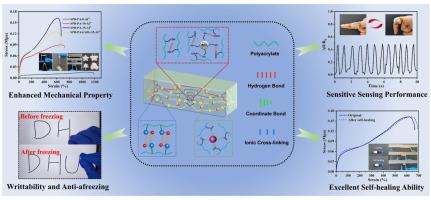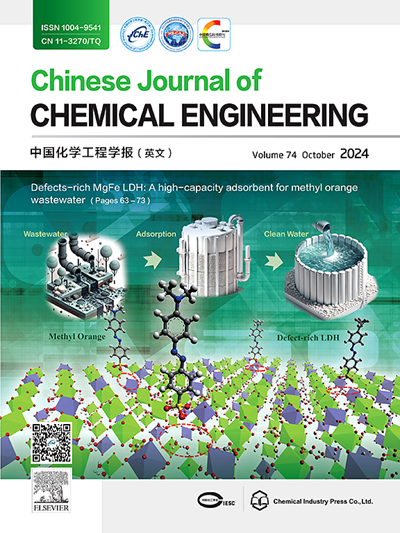可拉伸,防冻和自修复两性离子聚丙烯酸酯水凝胶,用于柔性可穿戴传感器
IF 3.7
3区 工程技术
Q2 ENGINEERING, CHEMICAL
引用次数: 0
摘要
传统的水凝胶在实际应用中不可避免地会受到破坏,导致其功能功效逐渐下降。解决这一问题的主要策略是开发具有内在自愈特性的水凝胶。在这项研究中,我们报道了一种融合两性离子、亲水纳米二氧化硅和铝离子的自修复聚丙烯酸酯水凝胶的合成。由于多个氢键、配位键和静电相互作用的协同作用,水凝胶的抗拉强度由15.1 kPa提高到162.6 kPa。室温下愈合20 min后,水凝胶的电阻和抗拉强度几乎可以恢复到初始值,表现出显著的自愈性能。此外,两性离子聚丙烯酸酯水凝胶作为可穿戴传感器,具有准确响应人体关节弯曲和拉伸的能力,在拉伸应变范围为80%至100%的情况下,其测量系数为1.87。即使在- 20°C冷冻3小时后,两性离子聚丙烯酸酯水凝胶仍保持其优异的书写性能。总之,本研究中开发的水凝胶在可穿戴电子应用中具有巨大的潜力。本文章由计算机程序翻译,如有差异,请以英文原文为准。

Stretchable, anti-freezing and self-healing zwitterionic polyacrylate hydrogels for flexible wearable sensors
Traditional hydrogels are inevitably damaged during practical applications, resulting in a gradual deterioration of their functional efficacy. A primary strategy to address this issue involves developing hydrogels with inherent self-healing properties. In this study, we report the synthesis of self-healing polyacrylate hydrogels that integrate zwitterions, hydrophilic nano-silica and aluminum ions. Due to the synergistic effect of multiple hydrogen bonds, coordination bonds and electrostatic interactions, the tensile strength of the hydrogel is enhanced from 15.1 to 162.6 kPa. Moreover, the electrical resistance and tensile strength of the hydrogel can almost recover to its initial values after 20 min of healing at room temperature, exhibiting remarkable self-healing performance. Furthermore, the zwitterionic polyacrylate hydrogel serves as a wearable sensor with the capability of accurately response to the bending and stretching of human joints, exhibting a gauge factor of 1.87 under tensile strain ranging from 80% to 100%. Even after being freezed at −20 °C for 3 h, the zwitterionic polyacrylate hydrogel retains its exceptional writing performance. In conclusion, the hydrogels developed in this study demonstrate significant potential for wearable electronics applications.
求助全文
通过发布文献求助,成功后即可免费获取论文全文。
去求助
来源期刊

Chinese Journal of Chemical Engineering
工程技术-工程:化工
CiteScore
6.60
自引率
5.30%
发文量
4309
审稿时长
31 days
期刊介绍:
The Chinese Journal of Chemical Engineering (Monthly, started in 1982) is the official journal of the Chemical Industry and Engineering Society of China and published by the Chemical Industry Press Co. Ltd. The aim of the journal is to develop the international exchange of scientific and technical information in the field of chemical engineering. It publishes original research papers that cover the major advancements and achievements in chemical engineering in China as well as some articles from overseas contributors.
The topics of journal include chemical engineering, chemical technology, biochemical engineering, energy and environmental engineering and other relevant fields. Papers are published on the basis of their relevance to theoretical research, practical application or potential uses in the industry as Research Papers, Communications, Reviews and Perspectives. Prominent domestic and overseas chemical experts and scholars have been invited to form an International Advisory Board and the Editorial Committee. It enjoys recognition among Chinese academia and industry as a reliable source of information of what is going on in chemical engineering research, both domestic and abroad.
 求助内容:
求助内容: 应助结果提醒方式:
应助结果提醒方式:


